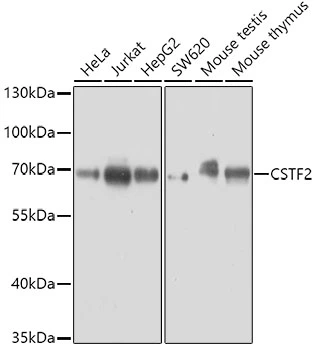CSTF2 antibody [N1N2], N-term
GTX114994
ApplicationsImmunoFluorescence, Western Blot, ImmunoCytoChemistry, ImmunoHistoChemistry, ImmunoHistoChemistry Paraffin
Product group Antibodies
ReactivityHuman
TargetCSTF2
Overview
- SupplierGeneTex
- Product NameCSTF2 antibody [N1N2], N-term
- Delivery Days Customer9
- Application Supplier NoteWB: 1:500-1:3000. ICC/IF: 1:100-1:1000. IHC-P: 1:100-1:1000. *Optimal dilutions/concentrations should be determined by the researcher.Not tested in other applications.
- ApplicationsImmunoFluorescence, Western Blot, ImmunoCytoChemistry, ImmunoHistoChemistry, ImmunoHistoChemistry Paraffin
- CertificationResearch Use Only
- ClonalityPolyclonal
- Concentration0.53 mg/ml
- ConjugateUnconjugated
- Gene ID1478
- Target nameCSTF2
- Target descriptioncleavage stimulation factor subunit 2
- Target synonymsCSTF64, CstF-64, XLID113, cleavage stimulation factor subunit 2, CF-1 64 kDa subunit, CSTF 64 kDa subunit, cleavage stimulation factor 64 kDa subunit, cleavage stimulation factor, 3' pre-RNA, subunit 2, 64kD, cleavage stimulation factor, 3' pre-RNA, subunit 2, 64kDa
- HostRabbit
- IsotypeIgG
- Protein IDP33240
- Protein NameCleavage stimulation factor subunit 2
- Scientific DescriptionThis gene encodes a nuclear protein with an RRM (RNA recognition motif) domain. The protein is a member of the cleavage stimulation factor (CSTF) complex that is involved in the 3 end cleavage and polyadenylation of pre-mRNAs. Specifically, this protein binds GU-rich elements within the 3-untranslated region of mRNAs. [provided by RefSeq]
- ReactivityHuman
- Storage Instruction-20°C or -80°C,2°C to 8°C
- UNSPSC12352203
References
- Zhang MH, Liu J. Cleavage stimulation factor 2 promotes malignant progression of liver hepatocellular carcinoma by activating phosphatidylinositol 3'-kinase/protein kinase B/mammalian target of rapamycin pathway. Bioengineered. 2022,13(4):10047-10060. doi: 10.1080/21655979.2022.2063100Read this paper







